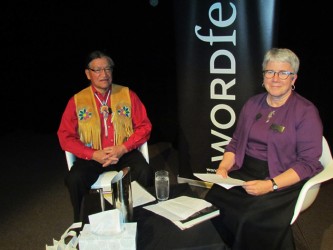Article Origin
Volume
Issue
Year
On Oct. 18, the Glenbow Museum exhibit Where Are the Children? Healing the Legacy of Residential Schools, opened in conjunction with Edmund Metatawabin’s reading from his book UpGhost River: A Chief’s Journey Through the Turbulent Waters of Native History.
Where Are the Children? Is a collection of 118 framed archival photographs that portray the residential school era beginning in the 1880s. The downloadable app that accompanies the exhibit is narrated by curator Jeff Thomas of the Six Nations Reserve in Ontario. In the 24 narrated stop points on the app, Thomas explains why the images were chosen, analyses their composition and symbolism, and describes the motivation of the photographer, pointing out how the photographs were staged and for what purpose.
In his introduction on the app, Thomas describes the challenge he faced when using archival photographs to represent the story of the residential schools.
“I found a large number of residential school photographs, but none that illustrated the kind of experiences that survivors had described nor that directly imaged the abuses survivors were disclosing,” said Thomas. “Instead, I had to weave a story from photographs that had been originally intended to show the so-called good work taking place at the schools and make that story meaningful to the Indigenous community not only the survivors, but their children and grandchildren, as wll as the youth that are feeling the intergenerational impacts of that horrific story.”
The technique he uses creates space for people to add their own voices to the exhibit and weave their own stories into it.
“I chose to use the storytelling tradition I learned from my Elders as the exhibition framework,” he said. “The photographs would tell a story, but not always the one they were originally intended to tell.”
In this way, Thomas makes room for the Aboriginal voice.
“There are new stories waiting to come out of the photographs . . . . Rather than dismissing them simply as images of colonization or racism we can choose as Indigenous people to make them our own, to add them to our own stories and to give the children of residential schools a voice. I envision the exhibition space of Where Are the Children as one of where the children’s voices could finally be heard,” he said. “In the end, I believe we can choose how much power we want to give these images.”
Edmund Metatawabin is one such voice. Having been separated from his family and sent to St. Anne’s residential school at age seven, Metatawabin’s life story folds into the exhibit as he relates how he survived the loss and the isolation he experienced.
In her conversation with Metatawabin, Donna Livingstone, Glenbow’s president and CEO Livingstone said, “There are survivors in the story and exhibition . . . (it’s also) about people who didn’t survive. Is there a sense of community and obligation to others?”
Metatawabin, who takes kids on trips into the wilderness, teaching them traditional learnings, says he sees a lot of growth in a short time, a big part of which is learning to express emotion.
Where Are the Children? Healing the Legacy of Residential Schools will be on display until Jan. 4, 2015.
- 2196 views

